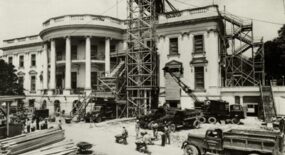Rebuilding the White House and U.S. Capitol
Copyright © White House Historical Association. All rights reserved under international copyright conventions. No part of this article may be reproduced or utilized in any form or by any means, electronic or mechanical, including photocopying, recording, or by any information storage and retrieval system, without permission in writing from the publisher. Requests for reprint permissions should be addressed to books@whha.org
On August 24, 1814, British forces marched into Washington, D.C. and set fire to the White House, the Capitol, and other government buildings. After the British left the city, the government hired James Hoban, designer of the original President's House, to supervise the rebuilding of the mansion and executive office buildings, while Benjamin H. Latrobe returned as Architect of the Capitol. Hoban and his crew had taken nearly ten years to build the first President's House; the post-fire restoration took about three years to make the mansion habitable again. They rebuilt the damaged walls and restored the intricately carved stone ornaments. But they also made a few changes. Hoban used timber framing instead of brick to reconstruct the interior walls and substructure in order to finish the work quickly. Over the next century, the timber framing deteriorated as the White House required major structural work in 1902 and 1927. In 1948, the Trumans moved out of the White House so it could be completed gutting. Over the three and a half years, construction crews built a skeleton of steel structural beams on a new concrete foundation, before rebuilding the decorative interiors.

The 1818 Robert King Jr.'s map of Washington, D.C. depicted the appearance of the White House and Capitol, as they would be restored. Hoban's south portico was not completed until 1824 and the map reproduced Thornton's design for the Capitol without the modifications by Latrobe.
Scorch marks
Despite the many rounds of renovations, the scorch marks of the fire are still visible today on the White House. The marks were discovered as the exterior of the White House underwent significant cleaning and restoration, a project that spanned from the Jimmy Carter administration to the Bill Clinton administration. They were left uncovered to share an important chapter of White House history. Legend suggests that the White House acquired its name when the house was painted white to cover the stone walls blackened by fire in 1814. In reality, the building was first painted with a lime-based whitewash in 1798, simply as a means of protecting the porous Aquia stone from freezing and spalling. The house acquired its nickname early on and can be found in the correspondence of congressmen years before 1814. The official name in the nineteenth century was the President's House, but during the Victorian era "The Executive Mansion" was used on official letterhead. President Theodore Roosevelt made the White House the official name in 1901.

The scorch marks of the fire are still visible today on the White House as two areas have been left unpainted.
White House Collection/ House Historical AssociationIn 1815, workers and craftsmen began work to repair the burnt Capitol building. They carved out and replaced dark, begrimed stone around windows and doors, scrubbed smoke damage from interior walls, and hauled away debris. Latrobe chafed under the supervision of Samuel Lane, the Commissioner of Public Buildings, and President James Monroe, who valued speed over design considerations. In November 1817, Latrobe resigned due to continued interference by his superiors. Before leaving Washington, Latrobe restored the old House and Senate Chambers, considered today to be some of the finest neoclassical spaces in America. He also produced drawings for the central rotunda, which were completed by his successor Charles Bulfinch.































































